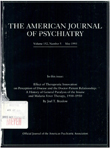A comparative study of paranoid and schizoid personality disorders
Abstract
OBJECTIVE: Family studies have demonstrated a higher rate of schizoid personality in the families of probands with schizophrenia and a higher rate of paranoid personality in the families of probands with delusional disorder. The authors sought to investigate the familial characteristics of probands with schizoid and paranoid personality disorders and to delineate the clinical characteristics of the two groups. METHOD: Records of 351 inpatients with discharge diagnoses that included the term "schizoid personality" or "paranoid personality" were examined to identify patients who met DSM-III-R criteria for schizoid personality disorder (N = 34) or paranoid personality disorder (N = 19). Comparisons were made between the two groups with respect to clinical symptoms, familial characteristics, and longitudinal course. RESULTS: The authors found that probands with schizoid personality disorder were hospitalized at an earlier age than probands with paranoid personality disorder, had more intervention before the index admission, and had greater morbidity following the index admission. They also found that descriptors of the two syndromes tended to congregate in the respective family material, but the differences were not statistically significant. Differences in the familial prevalence of schizophrenia were also not statistically significant. CONCLUSIONS: These familial data do not support the hypothesis that schizophrenia congregates in the families of probands with schizoid personality disorder. Possible explanations for this finding are discussed.
Access content
To read the fulltext, please use one of the options below to sign in or purchase access.- Personal login
- Institutional Login
- Sign in via OpenAthens
- Register for access
-
Please login/register if you wish to pair your device and check access availability.
Not a subscriber?
PsychiatryOnline subscription options offer access to the DSM-5 library, books, journals, CME, and patient resources. This all-in-one virtual library provides psychiatrists and mental health professionals with key resources for diagnosis, treatment, research, and professional development.
Need more help? PsychiatryOnline Customer Service may be reached by emailing [email protected] or by calling 800-368-5777 (in the U.S.) or 703-907-7322 (outside the U.S.).



